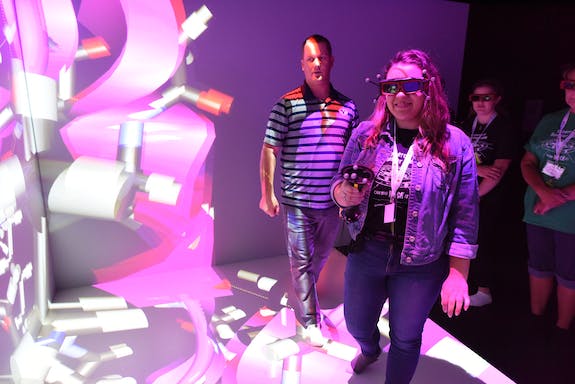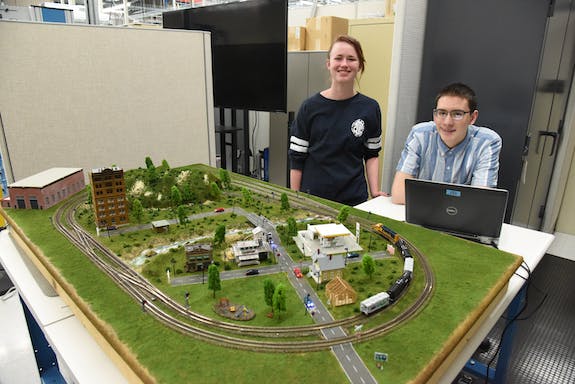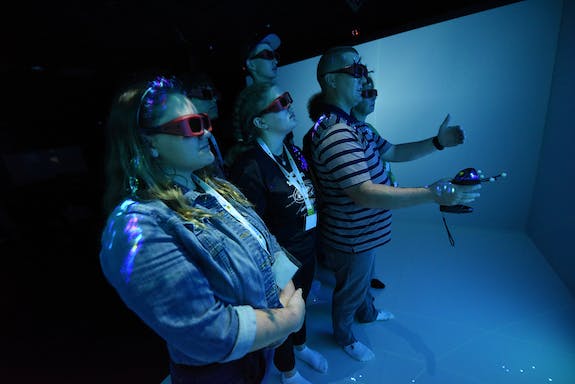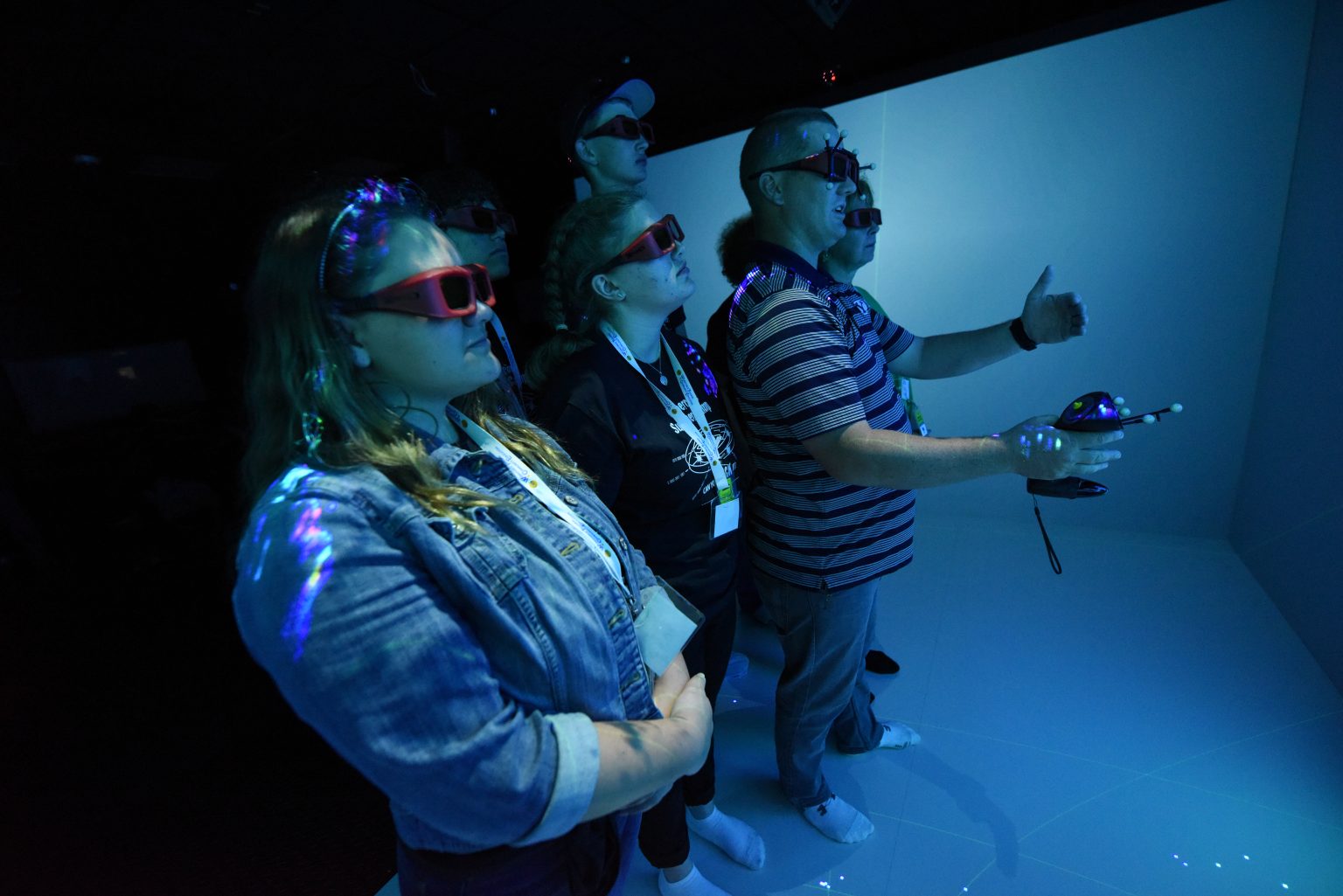Across Idaho, high school students and teachers are learning to fight cyberthreats.
This year marked the third Cybercore Summer Camp for area high school students and teachers, and the first year that cybersecurity was included in the STEM Summer Camp for younger students at the College of Eastern Idaho (CEI). It was also Idaho’s first year as a statewide participant in the national Girls Go CyberStart competition. And 2019 saw two area high school students spend the summer as cybersecurity interns at the laboratory. Here’s a recap of all the ways INL is building the cybersecurity workforce of the future.
Girls Go CyberStart
Girls Go CyberStart is a free online game open to high school students across the state of Idaho. Through a series of challenges, puzzles, games and other interactive events, students learn skills like computer forensics, web vulnerabilities, the Linux operating system and coding in Python.

In 2019, Idaho was one of 27 states that participated in the free national event developed by the SANS Institute, the world’s largest provider of cybersecurity training and professional certification. For more than a decade, INL has had a strategic partnership with the SANS Institute that includes sending researchers and training teams to SANS events to instruct audiences on industrial control system cybersecurity. When the opportunity arose to bring Girls Go CyberStart to Idaho, it was a natural fit and opportunity to encourage students to consider careers in cybersecurity.
The game is unique because students don’t need any prior experience or knowledge in cybersecurity or information technology to play. All that’s required is a laptop and internet access. As participants work their way through levels, the game gets more difficult. Playing alone or on teams, students solve challenges, gain points and advance through levels earning prizes along the way. In addition to individual prizes, such as trips, gift certificates, and computers, the three Idaho schools with the most participants win monetary prizes. Idaho girls who participate in the program are eligible to win one of at least 10 $500 scholarships for tuition at the college of their choice.
And although the program is called Girls Go CyberStart, boys can also participate. If at least five girls from a school form a team and complete six challenges, then the school wins access for 50 more students, boys or girls.
“The nation desperately needs more highly skilled cyber professionals, and we have evidence that CyberStart improves the quality and preparation of people entering the cybersecurity field,” said Alan Paller, SANS Institute’s director of research. “By opening CyberStart to thousands of girls in high school, we hope to help the nation identify the next generation of talented people who will excel in this critical field.”
Last year, more than 150 high school girls and boys participated in the Girls Go CyberStart program. Three Idaho high school teams scored well enough to earn prize money for their school or organization. A team from Idaho Falls Compass Academy was awarded $1,000, while a team from Boise-based Foothills School of Arts and Sciences was awarded $750, and a team from Coeur d’Alene’s Gizmo CDA was awarded $500. A team from Boise’s Centennial High School was one of 120 teams nationwide to advance to the national championship round in June. In 2019, more than 10,000 high school students from across the country participated in the competition.
The 2020 Girls Go CyberStart game is now registering high school students. The first phase of the game will begin on Jan. 13, 2020.
Cybercore Summer Camp
The Cybercore Summer Camp was piloted three years ago by INL cybersecurity researcher Bryan Hatton and support for the camp has come from INL, Idaho Falls Parks and Recreation, the Idaho STEM Action Center, CEI, the University of Idaho (UI), and Idaho State University. When asked about his motivation, Hatton said, “We have to give opportunities to these kids. At some point I want to retire, and I need someone smarter than me to replace me.”
For the past two years, the camp has been taught by UI Associate Professor Michael Haney, and Idaho Falls computer science teacher Cathy Owen. Hatton and a group of INL cybersecurity summer interns also participate. This year, 14 area high school-age students attended the first week of the camp at CEI, and nine attended the new second week of advanced materials held at University Place.

According to Haney, “The goal is to spark their interest and get them started so that they understand basic cyber concepts. We take away the intimidation factor and teach them how to find more information.”
Being a cybersecurity specialist requires a hacker skill set with ethics of steel. As Compass Academy Junior Raymond Kalkwarf put it, “This week was about experimenting with hacking and protecting from hackers.” The camp lets students explore hacking methods in a safe space, with mentors who help them understand what is right and wrong, and inspire them to act ethically.
During the course, students used Raspberry Pi microcomputers that they got to keep. With these microcomputers and the basic knowledge they gained in the course, the students will be able to take advantage of many publicly available coding and cybersecurity tutorials and experiment on their own.
The students in the advanced week enjoyed learning how to kick people off of Wi-Fi networks (an essential skill for fighting hackers). Many also shared Skyline High School sophomore Tanner Ward’s sentiment that, “Tech is growing fast and they need more people to defend against hackers.”
Some of the students, like Thunder Ridge High School senior Ethan Ricks, are planning on going into cybersecurity to protect people from hackers. Part of the inspiration to pursue careers in cybersecurity comes from working with INL interns. Jennifer Lopez, CEI’s Special Projects coordinator for Workforce Training and Continuing Education, said, “One of the most impactful days was when the students got to sit down and interview the interns. They learned that there is a whole world of options out there.”
Most aren’t set on careers yet, but this camp has made them think. As Taylor’s Crossing Public Charter School senior Kaeleigh Kotter said, “Ever since I started the cybersecurity camp, I will be playing a game and I will start thinking about how much work went into it.”
Cybersecurity teacher training
In addition to exciting students, the Cybercore Summer Camp inspired teachers. According to instructor Owen, “Everybody thinks that cybersecurity education is happening in the schools, but mostly it’s not.”
In order to broaden the impact of the camp and in response to an initiative to increase cyber programs in the schools by 2020, Owen created a cybersecurity curriculum and lesson plans to share with East Idaho area teachers. Five teachers attended the first week of the summer camp. They worked alongside students to learn the basic concepts that would help them to teach the curriculum at their schools.
Cybersecurity at the CEI STEM Summer Camp
Owen runs the Compass Academy Girls Who Code Club in Idaho Falls and mentors a Girls Go CyberStart Team. In addition to co-instructing the Cybercore Summer Camp, she was an instructor in the annual STEM Summer Camp at CEI. This year, she added a cybersecurity module.
“It’s important to show students how they can use the computer for more than just gaming,” Owen said. She created lessons that were fun for students and also inspired them to think about the real-world problems that computers can help solve.
Basic coding is the most important building block for any career in computers, but Owen thought her 10- to 12-year-old CEI STEM summer camp students could do more. She incorporated advanced material and included coding challenges. Students learned to hack Minecraft and control lights.
“A lot of schools are using coding for play but not demonstrating the real world power of it,” she said. By presenting the students with challenges like cybersecurity problems, Owen is showing them that computer coding isn’t just something new to learn, it’s a tool to make amazing things happen.
Cybersecurity internships at INL
This summer, two local high schoolers enjoyed nearly three months of real-world cybersecurity research experience as interns in INL’s cybercore program. The cybersecurity challenges and new technologies they spent the summer working on can only be addressed at a handful of sites around the world.

Kason Summers, a junior at Hillcrest High School in Idaho Falls, loves the idea of ethical hacking and laughingly said that his best cybersecurity advice is to “Throw out your smartphone.” He wasn’t about to do that either, but he did offer up another gem: “Always look at the link before you click it. Just because it looks safe, doesn’t mean it is safe. You can even preview tiny URLs before you click them.”
Summers learned about the Cybercore Summer Camp from a neighbor who is an INL employee. After two years of participating, he was ready to learn more. He spent part of his internship this summer developing cybersafe environments for INL researchers to perform their experiments and collaborating with graduate student interns from New Mexico Tech. Summers plans to intern again at INL next summer and to major in computer science and minor in cybersecurity when he gets to college.
Angela Torres, a senior at North Fremont High School in Ashton, is all about breaking barriers. She is the first student from her school to do an internship at INL, was in the first class of Cybercore Summer Camp students and is the first high school student to do an Industrial Control Systems Certification at INL. As the oldest child in her family, she likes showing her younger siblings what she is doing and inspiring them to succeed. As one of just two Idaho students to win the Girls Go CyberStart Scholarship last year, it looks like Torres knows quite a bit about how to do just that.

Torres’ advice: “Watch your emails – look out for phishing attacks. They are one of the biggest problems in the cybersecurity world right now.”
During her internship, Torres delved into a major cybersecurity challenge – how to protect communications between different wireless devices. A whole world of new products, from new baby monitors to self-driving cars, uses wireless communications to function and the best methods for protecting these devices from cyberattacks are still under development.
Torres also had the opportunity to collaborate with Summers and the graduate student interns. About the interns, she said, “They have a different mindset than the older researchers.” And she was baffled by the amount of knowledge the interns had. Torres was inspired and she wants to do the same for others. “I want little kids to look at me and say, ‘Look at her, she did it, I can, too,’” she said. There is no doubt that someday very soon, they will.
Meanwhile, students all over eastern Idaho will soon be learning more about cybersecurity and finding more opportunities to explore it further. In this new world of technology, it can’t happen fast enough. By supporting these programs and internships, INL is creating unprecedented opportunities for cybersecurity education in eastern Idaho.







